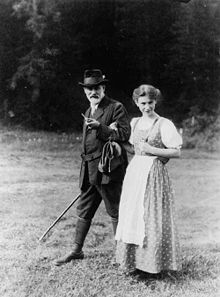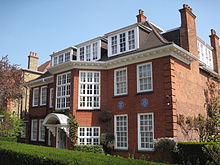Anna Freud
[3] After the Freud family were forced to leave Vienna in 1938 with the advent of the Nazi regime in Austria, she resumed her psychoanalytic practice and her pioneering work in child psychoanalysis in London, establishing the Hampstead Child Therapy Course and Clinic in 1952 (later renamed the Anna Freud National Centre for Children and Families) as a centre for therapy, training and research work.
"[5] Anna Freud appears to have had a comparatively unhappy childhood, in which she "never made a close or pleasurable relationship with her mother, and was instead nurtured by their Catholic nurse Josephine".
"[8] As well as this rivalry between the two sisters, Anna had become "a somewhat troubled youngster who complained to her father in candid letters how all sorts of unreasonable thoughts and feelings plagued her".
"[12] In adolescence, she took a precocious interest in her father's work and was allowed to sit in on the meetings of the newly established Vienna Psychoanalytical Society, which Freud convened at his home.
The steady flow of foreign visitors to the Freud household inspired Anna to emulate her father by becoming proficient in different languages, and she soon mastered English and French and acquired some basic Italian.
[16] For her performance during the school years 1915–18, she was highly praised by her superior, Salka Goldman, who wrote that she showed "great zeal for all her responsibilities", but she was particularly appreciated for her "conscientious preparations" and for her "gift for teaching", being such a success that she was invited to stay on with a regular four-year contract starting in the fall of 1918.
As well as in the periods of analysis she had with her father (from 1918 to 1921 and from 1924 to 1929), their filial bond became further strengthened after Freud was diagnosed with cancer of the jaw in 1923, for which he would need numerous operations and the long-term nursing assistance that Anna provided.
[24] In 1927 Anna Freud and Burlingham set up a new school in collaboration with a family friend, Eva Rosenfeld, who ran a foster care home in the Hietzing district of Vienna.
Eventually, in 1928, Anna persuaded the parties concerned that a permanent move to Vienna was in Ernst's best interests, not least because he could resume analysis with her on a more regular basis.
[29] In 1938, following the Anschluss in which Nazi Germany occupied Austria, Anna was taken to Gestapo headquarters in Vienna for questioning on the activities of the International Psychoanalytical Association.
Unknown to her father, she and her brother Martin had obtained Veronal from Max Schur, the family doctor, in sufficient quantities to commit suicide if faced with torture or internment.
Premises were acquired in Hampstead, North London and in Essex to provide education and residential care with mothers encouraged to visit as often as practicable.
Freud and Burlingham went on to publish a series of observational studies on child development based on the work of the Nursery with a focus on the impact of stress on children and their capacity to find substitute affections among peers in the absence of their parents.
[31] The Bulldog Banks Home, run on similar lines to the Nursery, was established after the war for a group of children who had survived the concentration camps.
During the war years the hostility between Anna Freud and Melanie Klein and their respective followers in the British Psychoanalytic Society (BPS) grew more intense.
Their disagreements, which dated back to the 1920s, centered around the theory of the genesis of the super-ego and the consequent clinical approach to the pre-Oedipal child; Klein argued for play as an equivalent to free association in adult analyses.
Anna Freud opposed any such equivalence, proposing an educative intervention with the child until an appropriate level of ego development was reached at the Oedipal stage.
To avoid a terminal split in the BPS Ernest Jones, its president, chaired a number of "extraordinary business meetings" with the aim of defusing the conflict, and these continued during the war years.
In the following months she lost two of her American cousins, Henry Freud and Rosie Waldinger, and colleagues Heinz Hartmann and Max Schur.
She had further distress following the deaths of her partner Dorothy Burlingham's eldest son and daughter, both of whom had had extensive period of analysis with her as children in Vienna and as adults in London.
[44] Anna Freud's first article Beating Fantasies and Daydreams (1922),[43] "drew in part on her own inner life, but th[at] ... made her contribution no less scientific".
[46] Her father, Sigmund Freud, had earlier covered very similar ground in A Child is Being Beaten – "they both used material from her analysis as clinical illustration in their sometimes complementary papers"[47] – in which he highlighted a female case where "an elaborate superstructure of day-dreams, which was of great significance for the life of the person concerned, had grown up over the masochistic beating-phantasy ... [one] which almost rose to the level of a work of art".
[55] The problem posed in adolescence by physiological maturation has been stated forcefully by Anna Freud: "Aggressive impulses are intensified to the point of complete unruliness, hunger becomes voracity...
[56] Selma Fraiberg's tribute of 1959 that "The writings of Anna Freud on ego psychology and her studies in early child development have illuminated the world of childhood for workers in the most varied professions and have been for me my introduction and most valuable guide"[57] spoke at that time for most of psychoanalysis outside the Kleinian heartland.
Arguably, however, it was in Anna Freud's London years "that she wrote her most distinguished psychoanalytic papers – including 'About Losing and Being Lost', which everyone should read regardless of their interest in psychoanalysis".
[58] Her description therein of "simultaneous urges to remain loyal to the dead and to turn towards new ties with the living"[59] may perhaps reflect her own mourning process after her father's recent death.
Focusing thereafter on research, observation and treatment of children, Anna Freud established a group of prominent child developmental analysts (which included Erik Erikson, Elisabeth Geleerd, Edith Jacobson and Margaret Mahler) who noticed that children's symptoms were ultimately analogue to personality disorders among adults and thus often related to developmental stages.
In her theoretical work there would be little criticism of him, and she would make what is still the finest contribution to the psychoanalytic understanding of passivity,[61] or what she termed "altruistic surrender, excessive concern and anxiety for the lives of his love objects".



